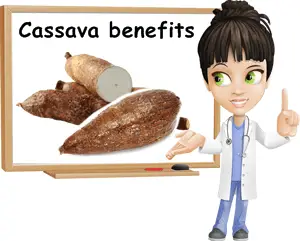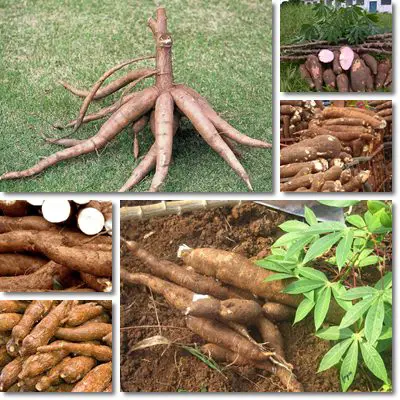Tapioca, yuca or cassava (scientifically known as Manihot esculenta) is an edible root vegetable grown extensively in South America, Africa and Asia. Gluten-free, rich in calories and a good source of essential nutrients such as B vitamins, copper, iron, magnesium, manganese, potassium and zinc, cassava is a valuable staple food with beneficial effects on the cardiovascular, digestive and immune systems in particular.
As a root vegetable, it holds a nutritional value similar to that of potatoes, its two most important properties being its lack of gluten and rich carbohydrate content.
Cassava is a major staple crop in both tropical and subtropical parts of the world, preferred for its low maintenance and culinary versatility. While it is packed with carbohydrates, gluten-free, drought-resistant as well as highly yielding as a staple crop, cassava is unsafe for consumption in raw form and undercooked. Should it make its way on a restaurant menu or in your local supermarket, you need to know how to make it edible and safe for consumption.

What is cassava?
Cassava is a plant grown in tropical and subtropical regions, known for its edible roots. It is slightly less nutritious than the ordinary potato and toxic if not properly cooked. Cassava is also known by the following names: yuca, manioca, mandioca or manioka, tapioca (actually referring to dried, powdered cassava roots), Brazilian arrowroot (due to its arrow-like appearance), mogo, kappa and so on.
What does cassava look like?
As you can see from the image above, cassava looks like an ordinary root vegetable or woody root. It can weight up to several pounds and has an elongated, spear-like shape. Cassava roots have a brown, rough skin and a white, even yellowish flesh with a woody core lengthwise.
What does cassava taste like?
Cassava (yuca) has a texture reminiscent of a stringy potato or pumpkin flesh. The reason why it may appear slightly bitter to some people and slightly sweet to others is the roots’ cyanogenic glucoside content. Taste is believed to be influenced immensely by climatic conditions such as drought. However, cassava roots often have a bland, potato or paste-like taste. When cooked, they tend to have a slightly softer, more buttery consistency than potatoes.

What are the benefits of cassava?
What is cassava good for? Find out what are the top 5 nutrition facts and health benefits of cassava:
Rich source of carbohydrates
According to the National Nutrient Database for Standard Reference of the United States Department of Agriculture, cassava contains 38.06 g of carbohydrates per 100 g of roots. While carbohydrates are thought to be non-essential nutrients (meaning we can live without eating them), research has shown they are indispensable for keeping in good health (provided they are consumed in moderate amounts, from natural food sources). Carbohydrates from cassava are a great and rapid source of energy.
Is gluten-free
Cassava lacks gluten, a protein in wheat, rye, barley and other grains which makes dough elastic and bread chewy. Many people are either sensitive or completely intolerant to gluten, experiencing gas, bloating, diarrhea, vomiting, cramps and so on when exposed to it. The condition is known as celiac disease and it is an autoimmune response triggered at the level of the small intestine. While it is nutritionally inferior to other gluten-free cereals such as amaranth, buckwheat and quinoa, cassava flour is an alternative for celiac sufferers as well as people suffering from non-celiac gluten intolerance.
Rich in calories
While this may come as a surprise, it is sometimes a good thing for a food to be richer in calories. With 160 kcal/100 g, cassava helps support normal metabolism by helping reach an appropriate daily caloric intake. For people with a low income, cassava is both a good source of carbohydrates and protein and a moderately low source of B vitamins, amino acids and ascorbic acid.
Good source of vitamin C
Cassava is a pretty decent source of vitamin C, providing 34% of the RDA of the vitamin. Unfortunately, the cooking heat required to make it safe for consumption will most likely destroy most, if not all of its vitamin C content.
Contains good amounts of B vitamins and potassium
Cassava contains small amounts of important B vitamins such as folate, niacin, pyridoxine, riboflavin and thiamine as well as potassium. B vitamins support digestion as well as brain function, whereas potassium regulates body fluids and blood pressure, contributing to cardiovascular health.
Cassava side effects and toxicity
Despite this, cassava consumption poses some health risks. The plant has a fairly high linamarin and lotaustralin content. Linamarin and lotaustralin are two cyanogenic glucosides which release hydrogen cyanide, or prussic acid. In simpler words, cassava is toxic. Some varieties are more toxic than others. For instance, bitter cassava roots have a higher cyanogenic glucoside content, while sweeter varieties may have up to 50 times less toxins. Usually, crops withstanding severe drought have a significantly higher cyanogenic glucoside content, hence their bitterness.
Signs and symptoms of cassava poisoning
It is not recommended to eat cassava continuously due to the fact that constant exposure to the toxins can alter thyroid activity and cause goiter, damage nerves and cause a form of paralysis known as konzo, pancreatitis and even death.
Conclusion
How to make cassava (yuca) safe for consumption? It is recommended to avoid eating raw cassava roots and leaves, no matter the variety (sweet or bitter). Boiling the smaller roots is a great way to make them safe for consumption: the toxins in cassava are released in the boiling water, which is then discarded to prevent intoxication. It is believed that peeling and fermentation have been shown to also help reduce the toxin content in cassava roots. Soaking, drying, grinding are not sufficient. Unfortunately, cooking heat will destroy the vitamins in the tubers as well, especially vitamin C, while peeling will get rid of most of the fiber content. Still, it is a small price to pay to make the vegetable edible and safe for consumption.
